Uffizi Artists | Location | Opening Hours Tickets | Authorizations
Artists Botticelli | Michelangelo | Da Vinci | Caravaggio | Raphael | Titian | Giorgione | Medici | Dürer Cranach Memling | Credi Bartolomeo | Rubens
Raphael at the Uffizi Gallery in Florence
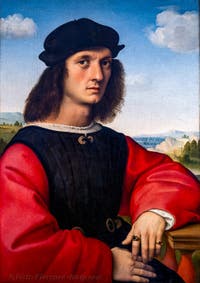
Raphael Agnolo Doni Raphael was in Florence from 1504 to 1508, during which time he produced numerous portraits and sacred works to satisfy the demand of many families of the rich Florentine bourgeoisie.
Among these works is the portrait of Agnolo Doni, a wealthy Florentine merchant, and his wife Maddalena Strozzi Doni.
According to Giorgo Vasari, these two paintings were commissioned from Raphael just after their marriage.
Angelo Doni was also behind the commission to Michelangelo of the painting of the Holy Family, aptly named the “Doni Tondo”.
Angelo Doni had married Maddalena Strozzi and, in the hope of the birth of their first child, wanted to give his wife a beautiful image of the Holy Family.
A little girl was born on 8 September 1507, the feast day of the Nativity of the Virgin, and they naturally named her Mary.
Raphael “The Madonna of the Goldfinch”
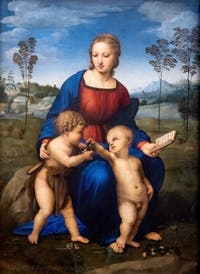
Madonna of the Goldfinch Painting - Oil on Wood (107 x 77.2 cm) 1505-1506
It is important to recall the history of this painting by Raphael to better understand its meaning.
This painting was in fact painted by Raphael for his friend Lorenzo Nasi in celebration of his marriage.
The Virgin is depicted with St John the Baptist and the Infant Jesus.
The Virgin's simple, graceful and gentle features refer to Nasi's wife.
Here, Raphael also emphasises the bonds of friendship between the little saint and Jesus, to whom he brings the goldfinch.
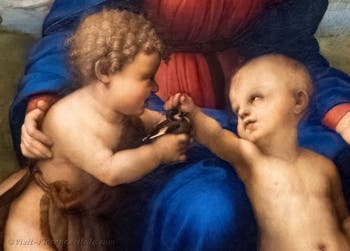
Madonna of the Goldfinch The friendship so beautifully expressed in this painting is that which binds Raphael to Lorenzo Nasi.
In addition to the divine elements presented in this painting, Raphael adds the elements of human happiness: kindness, maternal love, brotherhood, the joys of childhood and nature.
In this scene, we see the Virgin holding the book of Scriptures, still open at the end of her arm, a book she was reading to the Infant Jesus when the little Saint John ran towards them holding the goldfinch in his hands.
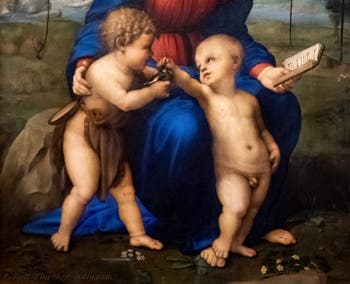
Madonna of the Goldfinch Raphael shows us the Word and St John the Forerunner, the son of Elizabeth, on whose back she places her hand as if he were her own son, thus leading us quite naturally from the divine to humanity.
The two children are both divine and so human.
A humanity and a divine bond, including in the gesture of the Child Jesus who places his foot on that of his mother.
Here, Raphael was inspired by Michelangelo's sculpture the "Madonna of Bruges", in which the infant Jesus also places his foot on that of the Virgin.
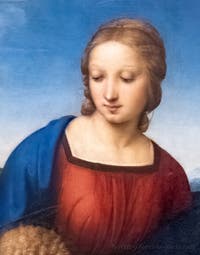
Madonna of the Goldfinch The portrait of the Virgin in this painting by Raphael is certainly an expression of the beauty found in his works, but above all of purity, goodness, gentleness and humility. This humility can be seen in the Virgin's simple clothing, without embroidery, gold or jewellery.
A modesty that is also evident in her features, in the tenderness expressed on her face, as well as in her simple hairstyle, without any styling product, which frames her peaceful face.
The Virgin and the two children are depicted in front of a pastoral landscape, with a small bridge reminiscent of the one in “alla Badia”, near Florence.
In the background, you can also see the city of Florence and the church of Santa Maria del Fiore, recognisable by its dome designed by Brunelleschi.
Raphael (1483-1520) “Portrait of Pope Julius II della Rovere”
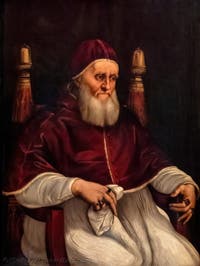
Pope Julius II Painting - Oil on Wood (108.7 x 80.3 cm) 1512
This portrait of Pope Julius II shows him a year before his death, already ill and having just suffered the defeat of Ravenna against the French in 1512.
In this portrait by Raphael, we no longer see the pope who led so many wars, demanding, threatening, feared.
He is now just an old man, almost benevolent, with lined features, but with a still lively gaze.
In addition to his eyes, which reveal his intelligence, the pope's mouth, with its pursed lips, still bears witness to his determination.
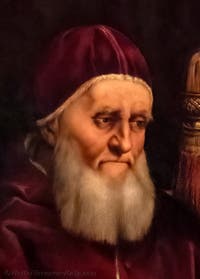
Pope Julius II Pope Julius II is seated on the “Sedia Gestatoria” with velvet-covered armrests and two bronze tassels decorated with golden fringes.
His hands are adorned with several rings set with precious stones, the only visible sign of wealth, which contrasts with the simplicity of his clothing.
Julius II was both a warrior pope, but also one of those who enabled the greatest artists of his time to express themselves by calling them to Rome, such as Raphael, but also Michelangelo and Bramante.
It was also he who made it possible to discover many works buried since Antiquity, including the famous Laocoön.
Finally, again on his initiative, we can still admire today the superb frescoes of the Vatican, including those of the Signature Room and his famous “School of Athens” painted by Raphael.
Raphael (1483-1520) “Saint John the Baptist in the Desert”
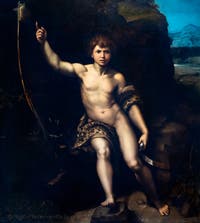
Saint John the Baptist Painting - Oil on Canvas (163 x 147 cm) 1518-1520
This painting was painted by Raphael for Cardinal Colonna, probably as a gift for Pope Giovanni Medici, who had made him a cardinal in 1517.
In this painting, Raphael shows us a young John the Baptist of about fifteen years of age, naked except for a wild animal skin that surrounds his right arm and passes behind him, covering the opposite thigh.
He is sitting on a tree trunk in a rocky landscape, near a stream whose waters are the emblem of the purity of the Christian faith.
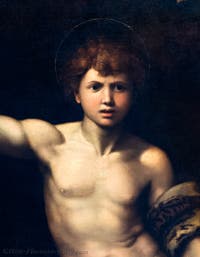
Saint John the Baptist On one of the remaining branches of this tree trunk, St John the Baptist has fixed his reed cross, an illuminated cross that he points out to us with the index finger of his right hand, thus alluding to the Passion and the death of Christ
Saint John the Baptist holds in his left hand a banner on which can be read “DEI”, the end of the formula “Ecce Agnus Dei” that the Baptist addresses to Christ.
Aesthetically, what is most striking is the beauty of the face, as well as the tone and softness of the skin, which contrasts with the shadows surrounding it.
The expression on the young saint's face also reveals a determination far beyond his years.
Artists Botticelli | Michelangelo | Da Vinci | Caravaggio | Raphael | Titian | Giorgione | Medici | Dürer Cranach Memling | Credi Bartolomeo | Rubens
Uffizi Artists | Location | Opening Hours Tickets | Authorizations
Back to Top of Page













